MEGACITY
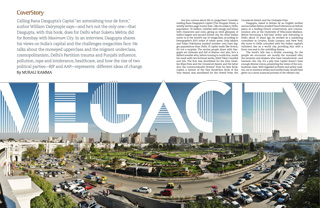
Calling Rana Dasgupta’s Capital “an astonishing tour de force,” author William Dalrymple says—and he’s not the only one—that Dasgupta, with this book, does for Delhi what Suketu Mehta did for Bombay with Maximum City. In an interview, Dasgupta shares his views on India’s capital and the challenges megacities face. He talks about the moneyed upperclass and the migrant underclass, cosmopolitanism, Delhi’s Partition trauma and Punjabi influence, pollution, rape and intolerance, healthcare, and how the rise of two political parties—BJP and AAP—represents different ideas of change.
Are you curious about life in megacities? Consider reading Rana Dasgupta’s Capital (The Penguin Press), a nimbly written page-turner that—like its subject, Delhi, population 25 million—bristles with energy and brims with characters and color, giving us vivid glimpses of India’s largest and second richest city. No other Indian metro is in the world’s top 10 megacities, according to Demographia’s 2015 index of urban areas. Only Jakarta and Tokyo-Yokohama (ranked number one) have bigger populations than Delhi. If Capital reads like fiction, it’s not a surprise. The stories people share with Dasgupta are intimate and full of drama—but also, he’s a skilled novelist who, before turning to nonfiction, made his mark with two fictional works, titled Tokyo Cancelled and Solo. The first was shortlisted for the John Llewllyn Rhys Prize and the Crossword Award, and the latter won the Commonwealth Writers’ Prize for Best Book. Capital, a winner of the Tata Nonfiction Book of the Year Award, was shortlisted for the Orwell Prize, the Crossword Award, and the Ondaatje Prize.
Dasgupta, raised in Britain by an English mother and an Indian father, studied French literature at Oxford, piano at a leading French conservatory, and communication arts at the University of Wisconsin-Madison. Before becoming a full-time writer and relocating to Delhi, about 15 years ago, he worked as a marketing consultant in London, Kuala Lumpur, and New York. His move to Delhi coincided with the Indian capital’s turbulent rise as a world city, providing him with a front-row seat to the unfolding drama.
The book’s title has a double meaning, for the people we encounter are mostly the moneyed elite, the strutters and shakers who have transformed—and harmed—the city. It’s a pity that Capital doesn’t have enough diverse voices, presenting the views of the non-business class. Well-regarded activists and policy makers, not to mention artists and intellectuals, would have given us a more nuanced portrait of the vibrant city.
| When I go to England, which is where I grew up, I wonder where all the people are, and who anaesthetized everyone. Delhi connects me to a current of life that has been essential to my career as a writer. |
Then again, Dasgupta’s book is really about how the moneyed folks, especially the nouveau riche, remade Delhi in their own image. “They had changed the physical landscape of the city, they had infiltrated its political establishment, they had transformed the culture of its institutions—schools and nightclubs, hospitals and hotels,” he pointed out to Khabar. But that’s now changing, as he added in the interview that follows.
“We need better ideas of what capitalist
success looks like.”
—Rana Dasgupta
You have an eclectic background, and until now you were known as a novelist. So I’m curious to know how you ended up writing a big nonfiction book about Delhi—where you did not grow up—and why you chose to become a long-time resident of the city. Most Western expats in India don’t last more than a few years, I’d imagine.
I don’t recognize myself in that word. I am an immigrant to India—or perhaps, to use an old-fashioned word, an émigré. I have stayed in Delhi because, despite all the negativity I describe in my book, which can be everything from infuriating to soul-destroying, this city has massive energy, and energy is very magnetic. Addictive, even. When I go to England, which is where I grew up, I wonder where all the people are, and who anaesthetized everyone. Delhi connects me to a current of life that has been essential to my career as a writer.
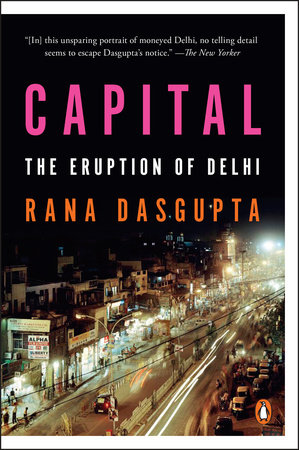
William Dalrymple and Sam Miller are two other Delhi-based Brits who have written books about the city. But Capital reminded me of an older Brit, V.S. Naipaul, whose last book about India was published a quarter-century ago. I’m wondering if his work inspired you in any way, because I see some parallels. Like him, you combine sharp analysis with profiles in which the interviewees do much of the talking to tell the story.
When you’re trying to tell a story, the first thing you have to do is work out how to tell it. With Capital, the story I wanted to tell was the one that had been going on all around me over the previous decade: the “eruption” of my adopted city, New Delhi. And the only possible way to tell that story, it seemed to me, was to report the words of its residents—especially its warrior-businessmen who seemed to define so much of the city’s ethos. It was an extreme time in Delhi, and no fictional imagination of its cast of characters could compare with actual lives and conversations. So I ended up, it’s true, with a form similar to that of Naipaul’s travelogues. But perhaps only because we both found ourselves up against the same calculus.
You once said that India and the U.S. “are both enormous and self-obsessed countries.” Megacities, though, often tend to be cosmopolitan. We think of them as less nationalistic or parochial than the countries they are in. Is that what you found in Delhi, and how has that evolved in the 15 years you’ve known it?
What is truly cosmopolitan today? Globalization often looks cosmopolitan, because, obviously, it encompasses the whole world. Even small towns are filled with products from all over the planet, and we have been trained to think that this makes them more “cosmopolitan.” The managers of capital come together from every different country and spend a lot of time on planes—and we can be fooled into thinking that this, too, is “cosmopolitanism.” But there is nothing profound about all this movement of capital, products, and people. It often disguises an extraordinary lack of variety in purpose and worldview, and a self-satisfaction that is quite different from what I think of as cosmopolitanism—which must include the understanding that there are many other theories of the world as good as one’s own. This is why I don’t think that today’s brand of globalization is incompatible with a deep parochialism in terms of culture and politics. Delhi is certainly a globalized city, but it is not a cosmopolitan city. Outsiders remain outsiders. And in some ways that is even more true now than it was fifteen years ago.
But Delhi, the only Indian metro among the world’s top 10 megacities, is quite different from other Indian metros, as you note. Cities like Kolkata and Chennai are more regional, and even Mumbai—India’s financial and film hub—has a strong local character that Delhi seems to lack. Is the Punjabi influence still dominant in Delhi, or has that changed?
Yes, the Punjabi influence is still dominant in Delhi, but it does not work in the same way as the Bengali “influence” in Kolkata, say. Delhi’s culture is not based on some supposedly ancient cultural continuity. If anything, it is the opposite: it is the serial destruction of historical cities and their cultures that gives Delhi its peculiar flavor. Today I would say that two things in particular shape the city’s ethos. One is the Partition of 1947, and the very specific set of traumas and ambitions with which the ensuing flood of Punjabi refugees arrived in Delhi and made it their own—their determination never to be so vulnerable again, for instance, or their fetishism of land and property. This has set the terms for business and culture even for the millions of non-Punjabis who have come to live in the city. The other is the fact that this is the seat of national politics and administration, and, since the expansion of industry and real estate over the last couple of decades has depended on political and bureaucratic support, this has created in the capital a conspicuously corrupt deal-making culture. The aggression and density of Delhi’s social life derives in large part from the very competitive “warrior” ethos that emerges from these two things.
Your grandparents and even your father experienced a syncretic culture. Then came Partition, and as you note, “the contemporary city was born out of trauma on a massive scale, and its culture is a traumatized culture.” Given the demographic changes and the successive waves of migration, why do you think the city is still “emotionally broken?”
Big historical traumas do not go away just because the people who experienced them grow old and die. They enter the culture and the language, and they persist. They become part of the software of a place, reprogramming everyone who comes to live there. The destruction of life and property but also—perhaps even more so—the destruction of that great, centuries-old, syncretic culture of which you speak—these things have not been adequately discussed or memorialized, and even people who were born forty years after Partition preserve very much of its paranoiac legacy. This is why making money, holding onto land, and building high walls around one’s house are all approached with such fervor in Delhi. Outsiders cannot function here without adopting that same fervor, and so the legacy of Partition is spread to everyone.
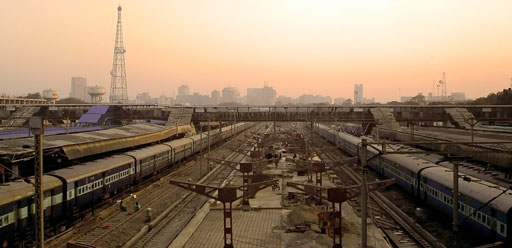
(Right) Delhi is a magnet for migrants. A view of the skyline from the train station.
You write movingly about Delhi’s vast underclass and the migrant workers who endure squalid living and working conditions in plain sight. And you say that the poor there are as remote from the rich as they are in the U.S. or Australia. Isn’t the gap starker in India?
The coefficients by which we measure wealth, growth, etc. mask great complexities, and these kinds of comparisons are always difficult to make. To begin with, it’s important to understand that India’s economic boom has had rather little effect on the broad quality of life of its 1.3 billion people, and in many ways India, with a per capita GDP of $1688, remains a “poorer” country than Bangladesh, whose per capita GDP is 25 percent less than this: malnutrition and infant mortality are significantly higher in India, for instance. It is true also that social mobility remains low in India, because educational and economic opportunity is so closely correlated to class.
At the same time, it is important not to be naïve about what kind of society the U.S. is. There, too, the per capita income of $56,000 conceals enormous inequality; there, too, poverty results in severe exclusion from healthcare and education—in fact one of the reasons that India has not performed better in certain basic respects is precisely that it pursues a very American path to economic “growth.” And though the absolute levels of Indian poverty are far more extreme than in the U.S., there are ways in which the American experience of poverty, where almost every resource necessary to a good life has a significant financial barrier to entry, is more devastating than in India. India is still a much less privatized society than the U.S., and the poor are able to create effective networks of mutuality and support. In addition to this, there is far more personal contact between the affluent and the poor in Delhi than in, say, Washington, D.C. American cities are extremely good at ghettoizing and concealing poverty, and affluent Americans often think, act, and vote as if it does not exist—which is not possible in India.
Medical care has improved tremendously in Indian cities, where corporate hospitals are seen as up-to-date and world class. But you call them money machines and tell some horror stories, like the ones shared by Aarti and Amit. Are you saying that for those who cannot afford the exorbitant costs, the quality of medical care has actually declined?
One should not mistake the ability to accumulate expensive commodities—state-of-the-art MRI scanners, or whatever—for a good system. The reason that life expectancy in the U.S., which has the fifth-highest GDP in the world, is only the 34th-highest—behind Cuba, Greece, and Lebanon—is because of the exceptionally privatized nature of its healthcare system, which creates enormous problems of access. Unfortunately, healthcare in India is following a similar model. But in India it is even worse because health insurance, which is a huge political issue in the U.S., is hardly even discussed—so as the whole system shifts from publicly-funded to corporate hospitals, many people are left either without adequate care or with enormous debts. Healthcare costs are one of the primary causes of indebtedness and poverty in India, and this is a sign that the system is really not working—and perhaps, therefore, that in the aggregate medical care has not really improved as much as we would like to imagine.
Delhi is infamously known as India’s “rape capital.” As you write, there’s been “a low-level, but widespread, war against women, whose new mobility made them not only the icons of India’s social and economic changes but also the scapegoats.” When do you think it started becoming such a huge problem? Given all the publicity since 2012, have you seen any progress in tackling it?
The new independence of middle-class women has been one of the most conspicuous signs of India’s new economy. Great numbers of women whose mothers never worked, navigated the city alone, or went out to meet friends in bars and restaurants, are doing all those things on a daily basis. Not everyone feels happy or secure about this. For some people, it represents a certain kind of cultural breakdown—especially, perhaps, those men for whom the liberalization period has introduced new challenges not only to their patriarchal power but also to their economic security. And yes, there has been a backlash against women who venture alone into city space—a backlash that mostly remains at the level of staring and taunting but that has on occasion reached grotesque extremes of violence.
The true problem here is very deep-seated, because it has to do with the culture itself, and the way in which men and women are defined. These things do not change quickly. But no one should imagine that Delhi society is numb to what has happened. Gender violence threatens everyone, and there has been much introspection since 2012. Not only have significant new legal measures been put in place, but a lot of film, literature, music, and activism has brought new perspectives on this issue. Many young people have taken it upon themselves to re-think the ideas of gender, family, etc. with which they will grow up. The events of 2012 fed into a new political consciousness that was budding in the city at that time, and they have not been forgotten.
Pollution, another consequence of the aggressive capitalism you write about, got a lot of press lately. Delhi is the world’s most polluted city, according to a WHO report. The diplomat Vikas Swarup mentioned to us that it has more cars than Mumbai, Kolkata, and Chennai put together. He also said that the government is serious about tackling the issue. Given the enormity of the challenge, how do you see it? Is Delhi a livable city today?
It is absolutely legitimate to be concerned about the quality of air—and water, too. In my book I take a walk along the river with a water expert who tells me the story of water in Delhi over the last several centuries, and it becomes clear that water management on this spot was far more scientific and successful in the seventeenth century than now. Water quality and shortages are a significant threat to today’s city, and, as we know from history, this is one of the ways in which cities in this region traditionally come to an end.
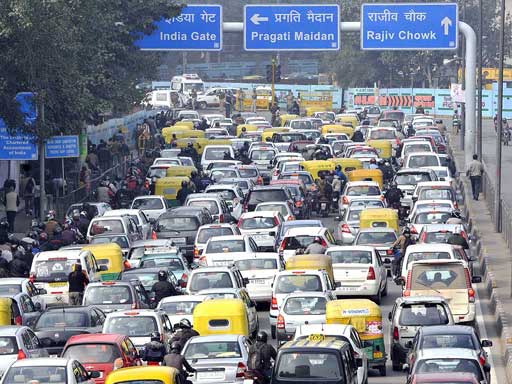
The air quality is terrible. Coughs and chest infections are endemic, and a lot worse, too. It is true that there have been significant initiatives to combat pollution—the superb Delhi Metro is the most impressive of these. But even with such large investments in public transport, there are a thousand new cars on the Delhi roads every day—in part because public transport is stigmatized by the middle classes, for whom the car remains the most important symbol of individual success. Ideally, the Delhi government would introduce Beijing-style restrictions on car use—allowing people to drive only on alternate days, for instance—and so force car owners to use public transport. But everyone realizes this would be politically unviable, which suggests that what really needs to happen—not only in Delhi but in much of the world—is that we need better ideas of what capitalist success looks like. Ideas that are less crude and more frugal. Buy a big car and sit in traffic for four hours a day with the air conditioner on full blast—that’s a pretty pathetic place to arrive.
But some of these problems might also level out organically. Megacities like Delhi have nearly reached their maximum populations. Nearly all urbanization over the next fifty years will take place in smaller cities as the costs of moving to megacities—which include things like air pollution—prove more overwhelming than the rewards.
You focus a lot on the moneyed class, and you point out how money has transformed both the exterior and interior lives of people in Delhi. Leaving aside those who got left behind, isn’t there a significant group of dissenters—I’m thinking of activists, writers, artists, intellectuals, and so on—who lead a different kind of life? Delhi, after all, is perhaps the most vibrant city in India. What sort of influence do they have, if any?
In my book, I focused on people who were making money—sometimes very big money, in one case billions—because the times had belonged to them in substantial ways. The 2000s were also boom years for the middle classes: everyone loved money, the rich were widely admired. But I think things have changed since then. To some extent there has been a rebirth of politics: no one thinks anymore that a successful society can be built just by its individual members making lots of money. Ideas are back, in a sense, and the successes of both Modi and Kejriwal are in some ways a reaction to the big “non-idea” of the last Congress administration.
In some ways this has also meant new audiences for those writers, thinkers, activists, etc.—and there are very many—who wish to criticize the status quo, or offer different visions. People born around the time of liberalization, who were ten years old when I arrived in Delhi, are now in their mid-twenties. They are reading, thinking, and going out. Unlike its elders, this generation has no respect for the mere fact of capitalism, which has been around all their lives: they are interested in making good lives for themselves within this furious new world, and at times they can be viciously critical of the system that so seduced and absorbed their parents. Most of the mails I receive about Capital come from people of this age group, and very thoughtful mails they are, too. Precisely because they are so steeped in capitalist culture, they have a much clearer idea of a “counterculture” than their elders. History never moves for too long in a single direction—and I very much hope that people who were not yet adults in the ’90s can help to pull us back into a more thoughtful and visionary place.
| A POSTSCRIPT TO CAPITAL |
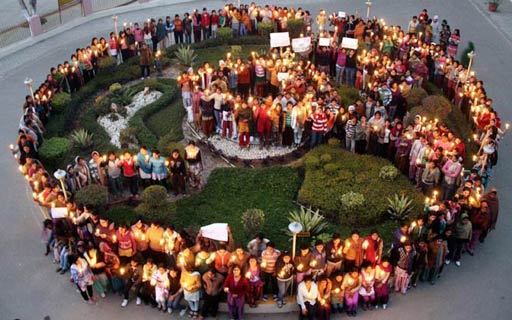
(Left) Jantar Mantar is a popular spot for political and social protests.
As Rana Dasgupta was finishing Capital, the streets of Delhi erupted in protests over issues like gender violence and political corruption. Things had reached a tipping point and there was a sense, even among outsiders, that the city wouldn’t be the same again. Sure enough, the Aaam Admi Party (AAP) came to power in Delhi—twice. At the national level, as the BJP unceremoniously pushed aside the dynastic Congress Party, two men battled over the political stage in the capital: Narendra Modi and Arvind Kejriwal. So what does Dasgupta think about the changes taking place in Delhi—and India?
Noting that AAP’s Kejriwal represents one possibility for the future of Delhi politics and possibly for Indian politics as a whole, he adds, “It is an egalitarian possibility, beginning with the reinvention of politics itself, which too often clings to old forms of inefficiency, arrogance, and obscurantism. Whether or not it is possible for Kejriwal to build sufficient support for this vision to set about overhauling the Indian political system is not clear yet, but there is no doubt that Indian politics is in need of such a new identity, whether Kejriwal is the author or not.”
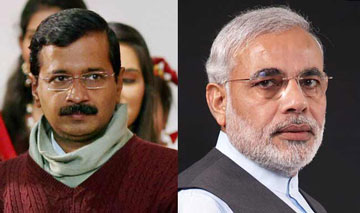
“Many people who voted for Kejriwal (L) in the Delhi elections also voted for Modi (R) in the national elections.”
What about Modi? Dasgupta thinks his vision is different, though he acknowledges that “many people who voted for Kejriwal in the Delhi elections also voted for Modi in the national elections, as if they felt that each of these visions needed to be hedged by the other.” And he’s disturbed by recent events in India.
“If Kejriwal is a somewhat ‘classical’ figure, who wants to create a society in which the idea of democracy is more completely realized, Modi is craftily contemporary, and he plays a much more dangerous game with Indian society,” Dasgupta says. “He is using an idea of Hindu majoritarian pride to try to pull Indian society together into a more authoritarian, more easily manipulated, and supposedly more economically dynamic machine—there are shades of Dubai or Singapore. There is a palpable climate of anxiety in the country now: liberal, secular institutions have been substantially undermined, and attacks on minorities seem to be on the increase. It is possible that such polarization will become far more perilous in the months and years to come. But it is unclear whether the Modi regime, for all its very tangible impact on civil society, can deliver on its economic promises. And there are probably limits also to how far Hindu chauvinism can be taken. So the Modi vision can collapse, too. But for now it is being energetically and sometimes callously implemented, and it is definitely changing Indian society.”
RANA DASGUPTA’S PASSAGE TO DELHI
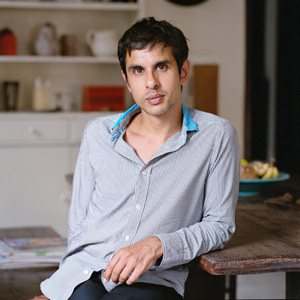
(Left) Dasgupta has lived in Delhi for 15 years. (Photo: Nina Subin)
At the dawn of the present century I was working for a marketing consultancy firm in New York. The job was becoming a burden: I was increasingly consumed by the novel I was trying to write in the evenings and, moreover, I was in love with a woman who lived on the other side of the world—in Delhi. And so, at the end of 2000, I emulated, contrariwise, my father’s journey.
At the time I arrived, Delhi had gone through a decade of the changes resulting from the ‘liberalization’ of 1991—that is to say, the reforms which led to the dismantling of the closed and centrally planned economy that had been in place since India’s independence, and which opened the country to global flows of products, media, and capital.
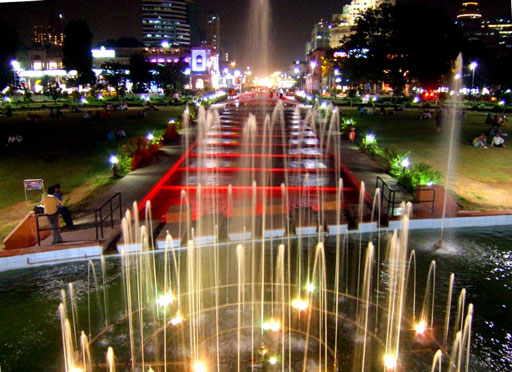
As far as life in the city was concerned, that decade before my arrival had been devoted mainly to what you could call changes to its ‘software,’ while its ‘hardware’ remained relatively untouched. Middle-class houses resounded with new commercial—and foreign—TV programming, and unfamiliar dreams unfurled in their whitewashed rooms, but their original architecture—balconies for the winter and darkened rooms for the summer—remained intact. Shops now stocked the imported jeans previously accessible only to those with contacts abroad, but they were still housed in the old cramped quarters of Connaught Place—the British-era commercial arcade—or in the ramshackle community markets built in the 1960s. The great tumult of destruction and creation that has dominated my acquaintance with Delhi, the furious tearing-down of all that hardware in the pursuit of globalism—“from Walled City to World City” as one of the leading newspapers sloganned it—still lay in the future.
That tearing-down would remove much of what was settled about Delhi. It removed, certainly, the homes of hundreds of thousands of the poor, in order that shopping malls and apartment complexes could be erected in their place: this enormous transfer of wealth and resources from the city’s poorest to its richest citizens turned many of the former into refugees in their own city, and made working-class life in general more edgy and precarious. Many of the businesses run by poorer entrepreneurs were destroyed in the 2000s in the name of aesthetic order—such as the informal tea stalls where you could order a cup of hot, sugary tea for 2 rupees, sit on a plastic chair and feel mysteriously insulated from the eddies of people and traffic all around. But the destruction also felled enormous numbers of houses of the affluent who, in their case, were cashing in on the real-estate boom of that decade by knocking down their properties and building blocks of apartments for sale. Built to maximize floor area and therefore sale price, these stern new blocks eschewed the generous terraces and balconies of the former architecture. Life retreated to the air conditioning inside, and so undid the cat’s cradle of inter-balcony conversations that had previously straddled the afternoons.
\\\\\\\\ \\\\\\\\ \\\\\\\\ \\\\\\\\ \\\\\\\\ \\\\\\\\
That bygone Delhi also shut down early. It has become difficult to remember, because the years after my arrival were occupied with the building of a glittering archipelago of cafes, restaurants, bars, and clubs, and now one can scarcely move in the city on weekend evenings for the traffic jams of fervent bar-goers. But none of this existed in 2000, when an older conservatism ruled the city’s nights, and when most areas were desolate after the shops shut down by 9 p.m. My neighbors, certainly, who believed in the virtues of home and early rising, had little truck with nights on the town. Profoundly shaped by the terrors and losses of Partition, this generation of Delhi’s middle classes was frugal and suspicious of the outside, and spending money in restaurants—and eating food cooked by unknown hands—was anathema to them. It was their Delhi I arrived in, a Delhi which—quite unlike the New York I had just left—made little attempt to seduce or entertain, and which sent you home when the day was done.
Even for the bohemians I now found myself amongst, the evening entertainment was, as it had been for such people for decades, domestic. We did not go out because there was nowhere to go. Instead we gathered in various apartments—small, bare, and, in those days, cheap—and, in rooms foggy with cigarette smoke, we sat on cushions on the floor around a motley assemblage of rum and whisky bottles, and we talked.
All conversation is infused with its moment; and it is through those nights of conversation that I realized I had landed in an extraordinary place and time.
Excerpted with the permission of The Penguin Press from Rana Dasgupta’s Capital: The Eruption of Delhi.
Enjoyed reading Khabar magazine? Subscribe to Khabar and get a full digital copy of this Indian-American community magazine.
blog comments powered by Disqus










